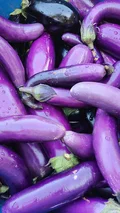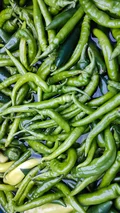TL;DR
Because of the good weather, we harvested lots of carrots, beets, celery, eggplant, fennel, and peppers. Similar to the way We empty beds to make room for new crops, I also have divested effort in some of my prior technology works.
Good Weather, Good Harvesting
Even on an organic farm, there are many timing ‘knobs’ that can be adjusted to make sure that you’re harvesting at just the right time. Mostly this involves knowing when the crop is ripe and ready to harvest, a long-cycle outcome of planting and caring for the crop well in advance of the actual harvest.
Weather however, is not something you can control, even sometimes with greenhouses. So it’s nice when nature cooperates and gives us a few uncharacteristically cooler mid-summer days to work out in the fields this week.
Yesterday we harvested lots of carrots, beets, celery, eggplant, fennel, and peppers…all before 3pm. The bugs weren’t bad because of the breeze. It was a lovely Monday for hours of physical activity outside. If only every day could be like this one.
All Things End
Some of the beds on this farm host the same crop season-long while others are rotated to different crops even within the same season. Either way, they have a lifecycle that ends at some point, but this is so they can begin again.
The heavy farming season around here will end at some point likely in October. This gives impetus for me to line up my winter tech work and contracts with clients to keep me busy until at least the spring. I may or may not also take that time to narrow in on a new career path and/or startup.
Indeed though, I have been putting many seeds in soils both on the farm and from a career perspective over the past year.
Specific Things that Must End
Last year was my final year for a few things. Specifically, I left an employer to pursue possibilities in agriculture. I volunteered on some farms and found one that I liked enough to work for the following (this) year and this year I no longer volunteer with others because there’s just not enough time to do so.
I also amicably ended my volunteer work with the Boston DevOps meetup, event organizing and non-profit board behind it. I divested because after 5 years I wasn’t seeing the growth I needed to justify the time investment. During the pandemic, I served as the president of the board, and put in place a succession plan that worked as intended.
In that time, we donated over $50,000 to local charities because we had done a great job in prior years of maintaining a strong community and fundraising. Unfortunately, there was a long-tail economic effect of the pandemic that caused many of our sponsors to divest from community events such as ours. It got harder and harder to sign on new sponsors in a model that never had that problem before 2020 and like many of our sibling events across the world, we saw a major decline in attendance and sponsorship.
All throughout that time, I was ‘planting seeds’ for how that community would rotate responsibilities and incorporate new folks while maintaining its core values. Some of those seeds blossomed and there are new community members and leaders now. Some of them, more deeply personal ones, did not. I did more than what most would to make sure the trust and respect was maintained, but I have to move on.
Divest to Invest
The fact is that I have limited resources…we all always do, some far more than others, but no one has infinite money and/or time. I have to divest from some things to invest in others.
I knew this in 2013 when I left the mundanity of cubicles at a college for high tech and higher pay, in 2016 when I switched from a toxic company to something higher paced, in 2021 when I handed off a lucrative front-of-house role so that I could run an incubation engineering team, and last year when I decided to leave the corporate world to carve a new path.
Like the tilled up radishes and carrots, you have to let some things go before you can move forward.
Daily Operations of This Blog
In the past two weeks, I’ve worked out a homegrown automated tagging strategy for all the images on this blog that are used in the gallery page. This is a process addition that takes a few minutes each time I add a blog post so it fits within the time constrains I set for myself each day.
Because of this spike work, I haven’t had as much time to build upon the AI summaries at the end of each post nor have I been able to find a suitable semantical section management format that will help me to parse this website as training input for LLMs. Now that the image tagging is out of the way though this will be my next goal.
For today at least, here’s the AI summary from my field notes:
AI Summary from Field Notes
Consolidated Summary
Main Themes
- Crop Management: Harvesting and planting of multiple crops (beets, carrots, eggplants, peppers, lettuce, radishes, etc.), emphasizing seasonal timing and pest/rot resistance.
- Tool Use: Introduction to a manual seeder for planting, its mechanics, and its role in seed dispersal.
- Weather and Irrigation: July’s cool, wet weather and reliance on irrigation systems for crop survival.
- Post-Harvest Processes: Storing eggplants in wash water, organizing harvested crops, and planning for fall share.
Key Activities
- Harvesting: Collected crops like eggplants, peppers, and carrots.
- Planting: Planted lettuce, radishes, carrots, and beets, using a manual seeder.
- Soil Preparation: Tilled soil for planting.
- Irrigation: Managed water distribution via an irrigation line.
- Post-Harvest: Stored eggplants in wash water, documented crop cycles, and planned for future planting.
New Learnings
- Seeder Use: Manual seeder effectiveness for different seed sizes (e.g., radishes vs. carrots).
- Irrigation: Adjusting the irrigation line for better water distribution.
- Lettuce Growth: Timing for summer planting vs. spring, and heat resistance.
- Pest Issues: Aphids, beetles, and their impact on crops.
- Eggplant Storage: Alternatives to wash water for preserving eggplants.
Future Research Questions
- How effective is the manual seeder for different seed types?
- Can the irrigation line be optimized for water efficiency during dry spells?
- Will lettuce survive summer heat, or will it require more frequent watering?
- What organic methods can control pests like aphids and beetles?
- How to best store eggplants to prevent spoilage?
Suggested Actions
- Test Seeder: Experiment with seed sizes to refine seeder settings.
- Monitor Irrigation: Track water usage and adjust the line for better distribution.
- Track Lettuce Growth: Document growth rates to adjust planting schedules.
- Implement Pest Control: Use neem oil or traps for organic pest management.
- Improve Eggplant Storage: Explore refrigeration or drying alternatives to wash water.
This summary integrates the original details into a cohesive, concise format, highlighting the intern’s experiences, challenges, and next steps in farm operations.
Part 1
Main Themes
- Harvesting and Crop Management: Focus on collecting crops like beets, carrots, eggplants, peppers, celery, and fennel, emphasizing their growth cycles and pest/rot resistance.
- Planting and Seedling Management: Involves sowing seeds for lettuce, carrots, and radishes, using a seeder and tilling techniques.
- Weather and Irrigation: The cool, wet July weather and reliance on irrigation systems to manage crop growth.
- Tool and Technique Learning: Introduction to a manual seeder, its mechanics, and its role in planting.
- Post-Harvest and Storage: Managing eggplants in wash water, organizing harvested crops, and preparing for fall share distribution.
Activities Performed by the Intern
- Harvested:
- Beets, carrots, celery, fennel, eggplants, peppers, and salad turnips.
- Planted:
- Lettuce (half a bed), carrots (a few rows), radishes (1–2 rows), and beets (an entire bed).
- Tilled Soil:
- Prepped soil for planting using manual tools.
- Used a Seeder:
- Learned to operate a manual seeder for seed planting.
- Managed Irrigation:
- Checked irrigation lines and used them as needed.
- Post-Harvest Tasks:
- Packaged eggplants in crates, cleaned the barn, and watered the greenhouse.
New Things Encountered
- Manual Seeder: A tool with an auger system for seed dispersal, described as a “tiny bike with long handles.”
- Different Pepper Varieties: Jalapenos (for planting) vs. habaneros (for harvest).
- Irrigation System: A movable line for dry periods, emphasizing its importance for crops.
- Eggplant Wash Water: Using water from washing eggplants for storage.
- Lettuce Planting Cycle: Timing for lettuce in July–August, contrasting with spring planting.
Questions and Future Research Areas
- Seeder Efficiency: How effective is the manual seeder for different seed sizes?
- Irrigation System Optimization: Can the irrigation line be adjusted for better water distribution?
- Lettuce Growth in Heat: Will lettuce survive the summer heat, or will it need more frequent watering?
- Pest Management: Are the pests (e.g., aphids, beetles) affecting the crops, and how can they be controlled?
- Eggplant Storage: How best to store eggplants in wash water to prevent spoilage?
Suggested Actions
- Test Seeder Mechanics: Experiment with seed types (e.g., radishes, carrots) to refine seeder settings.
- Monitor Irrigation Use: Track water usage during dry spells to optimize the irrigation line.
- Track Lettuce Growth: Document growth rates and adjust planting schedules for fall share.
- Develop Pest Control Plan: Introduce organic methods (e.g., neem oil, traps) to manage pests.
- Improve Eggplant Storage: Explore alternatives to wash water (e.g., refrigeration, drying) for better preservation.
This structured breakdown highlights the intern’s hands-on experience, challenges, and opportunities for growth in farm operations.
[end of post]
Enjoy Reading This Article?
Here are some more articles you might like to read next:










